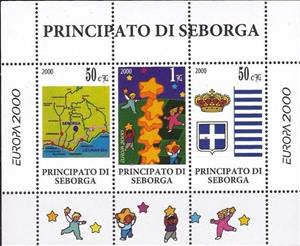Mini Sheet: Europa 2000 (Cinderellas 2000)
Europa 2000 (Cinderellas 2000)
01 January (Cinderellas ) within release Italy : Principality of Seborga goes into circulation Mini Sheet Europa 2000 face value 2 Seborgan luigino
| Mini Sheet Europa 2000 in catalogues | |
|---|---|
| Colnect codes: | Col: IT-SB 2000-03A |
Mini Sheet is square format.
Also in the issue Italy : Principality of Seborga:
- Stamp - Coat of Arms face value 1;
- Stamp - Coat of Arms face value 10;
- Stamp - Coat of Arms of Armand de Périgord face value 10;
- Stamp - Coat of Arms of Guillaume de Beaujeu face value 10;
- Stamp - Coat of Arms of Hugues de Payens face value 10;
- Stamp - Coat of Arms of Jacques de Molay face value 10;
- Stamp - Coat of Arms of Pierre de Montaigu face value 10;
- Stamp - Coat of Arms of Robert de Craon face value 10;
- Stamp - Coat of Arms of St Bernard of Clairvaux face value 10;
- Stamp - Coat of Arms of Tomaso Bérard face value 10;
- Stamp - Coat of Arms, 1148-1198 face value 10;
- Stamp - Coat of Arms, 1203-1256 face value 10;
- Stamp - Coat of Arms, 1258-1313 face value 10;
- Stamp - Coat of Arms, 1313-1443 face value 10;
- Stamp - Coat of Arms, 1443-1667 face value 10;
- Stamp - Coat of Arms, 1667-1706 face value 10;
- Stamp - Coat of Arms, 1707-1749 face value 10;
- Stamp - Coat of Arms, 1749-1814 face value 10;
- Stamp - Coat of Arms, 1814- face value 10;
- Mini Sheet - Coats of Arms of the Principality of Seborga in history face value 10*10;
- Mini Sheet - Europa 2000 face value 2;
- Mini Sheet - Europa 2000 face value 6*1;
- Stamp - EUROPA 2000 - Tower of Stars face value 1;
- Stamp - EUROPA 2000 - Tower of Stars face value 1;
- Stamp - Flag face value 1;
- Stamp - Flag face value 50;
- Mini Sheet - Grand Masters of the Cistercian Knighthood face value 10*10;
- Stamp - Jacques de Molay face value 10;
- Stamp - Map of Seborga face value 50;
- Stamp - Prince Giorgio I face value 1;
- Stamp - Saint Bernard of Clairvaux face value 10;
|
Data entry completed
46%
|
|
|---|---|
| Mini Sheet Europa 2000 in digits | |
| Country: | Cinderellas |
| Date: | 2000-01-01 |
| Emission: | Cinderella |
| Format: | Mini Sheet |
| Face Value: | 2 Seborgan luigino |
Mini Sheet Europa 2000 it reflects the thematic directions:
A coat of arms is an heraldic visual design on an escutcheon (i.e. shield), surcoat, or tabard. The coat of arms on an escutcheon forms the central element of the full heraldic achievement which in its whole consists of shield, supporters, crest, and motto. A coat of arms is traditionally unique to an individual person, family (except in the United Kingdom), state, organisation or corporation.
In British heraldry, a coronet is any crown whose bearer is less than sovereign or royal in rank, irrespective of the crown's appearance. In other languages, this distinction is not made, and usually the same word for crown is used irrespective of rank (German: Krone, Dutch: Kroon, Swedish: Krona, French: Couronne, etc.) In this use, the English coronet is a purely technical term for all heraldic images of crowns not used by a sovereign, and implies nothing about the actual shape of the crown depicted. A Coronet is another type of crown, but is reserved for the lower ranks of nobility like Marquesses and Marchionesses, Earls and Countesses, Barons and Baronesses, and some Lords and Ladies. The specific design and attributes of the crown or coronet signifies the hierarchy and ranking of its owner.
A map is a symbolic depiction emphasizing relationships between elements of some space, such as objects, regions, or themes. Many maps are static, fixed to paper or some other durable medium, while others are dynamic or interactive. Although most commonly used to depict geography, maps may represent any space, real or imagined, without regard to context or scale, such as in brain mapping, DNA mapping, or computer network topology mapping. The space being mapped may be two dimensional, such as the surface of the earth, three dimensional, such as the interior of the earth, or even more abstract spaces of any dimension, such as arise in modeling phenomena having many independent variables. Although the earliest maps known are of the heavens, geographic maps of territory have a very long tradition and exist from ancient times. The word "map" comes from the medieval Latin Mappa mundi, wherein mappa meant napkin or cloth and mundi the world. Thus, "map" became the shortened term referring to a two-dimensional representation of the surface of the world.
A star is a luminous spheroid of plasma held together by self-gravity. The nearest star to Earth is the Sun. Many other stars are visible to the naked eye at night; their immense distances from Earth make them appear as fixed points of light. The most prominent stars have been categorised into constellations and asterisms, and many of the brightest stars have proper names. Astronomers have assembled star catalogues that identify the known stars and provide standardized stellar designations. The observable universe contains an estimated 1022 to 1024 stars. Only about 4,000 of these stars are visible to the naked eye—all within the Milky Way galaxy.




